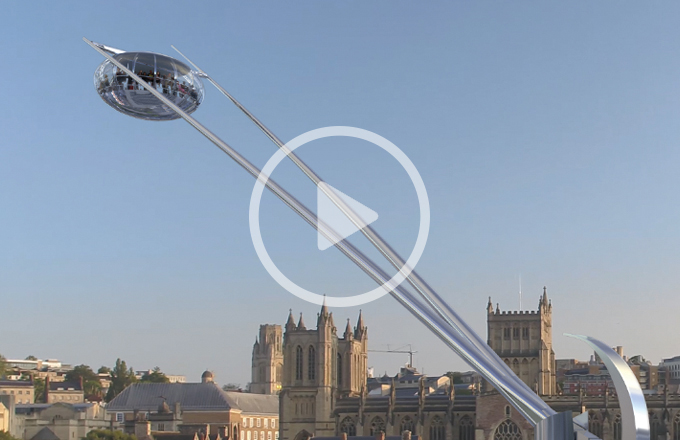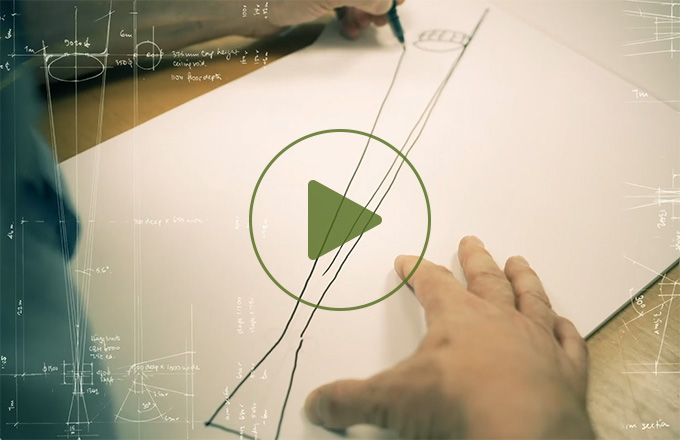FAQs
Ask a question
How is Arc powered?
When does it fly?
What is it made from?
Will it scare bats?
We get asked a lot of questions about our amazing concept. Here are a few...
- What exactly is Arc?
- Arc is a glass viewing capsule suspended between two carbon-fibre arms, which elevates passengers to a height of 69 metres (ground to eyeline). It has been designed as a way to view heritage and historic sites from the air, without impacting those sites.
- How does the machinery work?
- Arc’s glass capsule is firmly held between two thin carbon-fibre masts which flex as Arc ascends and descends. At its base, a 163-tonne counterweight balances the weight of passengers, masts and cabin. Accurate electric motors lift and lower the capsule as the whole assembly smoothly rotates.
- How is the flight controlled ?
- Arc will be, for most of the time, controlled by the pilot. An auto-pilot system will regularly land Arc and be ready to assume control if needs be. Arc will have mechnical stops adjusted for each location so that the flight path will always be safe.
- Could passengers fly Arc?
- Possibly. Any passenger-piloting would be under strict supervision and Arc’s programming will not allow a novice pilot to deviate dangerously from a flight area or operate Arc anything less than smoothly.
- What will Arc feel like to ride in?
- Smooth and safe yet exhilarating! You will see that you are moving through the air but Arc will feel like being in a luxury passenger lift or elevator.
- How many people can fly at any one time?
- 42 passengers plus crew.
- Will people stand or sit?
- 24 removable ergonomic seats will be provided with 18 places for passengers to stand or use a wheelchair. Passengers on dinner flights will sit at tables.
- Could there be evening bookings for the capsule?
- Yes, the capsule will be used for a wide variety of celebrations and events.
- Will there be wheelchair access?
- Yes. Arc and the entire Arc experience will be fully accessible to all.
- Where will people buy their tickets?
- In We The Curious, online and via travel agents, hotels, city tourist bureaux and other venues.
- Will there be queues?
- No. Tickets will be purchased in advance for specific flights. The 140 or so people present at each changeover will be comfortably accommodated in the reception.
- Can anyone take a flight on Arc?
- Yes - Arc is designed as an educational experience, not just an entertaining one. We will welcome all ages.
- How much will a ticket be?
- We haven’t yet set prices for Arc tickets. Your views on prices will help us set them in line with those of other attractions.
- Where will people board the capsule?
- Your pilot will meet you at check-in, go through security and safety checks before directing you to the roof top lounge. Your journey will begin in the lounge theatre with a fascinating sound and light show about the city before boarding your flight. Afterwards, you will be able to enjoy refreshments in the lounge café and chat to teams working on new stories from around the city for when you visit next time.
- Could I bring a buggy on board?
- Yes. Alternatively, your buggy can be left at the cloakroom, along with coats and bags.
- Could I get married on Arc?
- Yes, Arc is likely to be a licensed venue for marriages.
- What is Arc made from?
- The masts will be made from high strength carbon fibre. The cabin will be made from carbon fibre, glass and aluminum. The base will be in steel.
- How heavy is Arc?
- The total weight of Arc’s structure including the counterbalance will be around 214 tonnes.
- How high is Arc?
- Arc rises to 69 metres high at eye-level. This height has been specifically chosen to allow passengers to be able to see the city, but still be close enough to pick out its detail.
- How long will Arc take to get up to full height?
- The ascent from take-off to full height will be approximately two minutes.
- Will Arc get dirty, or rust over time and look ugly?
- Being built of carbon fibre, the masts and cabin will not rust. Glass will have a special coating to keep it clean.
- What colour will Arc be?
- The masts will be finished in a mirror finish. This reflects the environment around and acts like camouflage as Arc rises.
- How is Arc funded?
- Other aerial attractions have come with a cost to a city which runs into many millions of pounds (and some of these have still failed).
Arc is completely different. Because it is self-funded from ticket sales, the cost to your city is zero. In fact the city benefits financially – from the increase in visitors, from increased trade for local businesses and from the percentage of profits that are channeled back into the local community. Arc does a host city good. - Can my business get involved with Arc somehow?
- There are many ways that local businesses can benefit from Arc. We’ll be sharing these nearer to the launch.
- How have Arc’s designers considered the environment?
- ‘The Environment’ covers many areas – climate change, ecology, sustainability, heritage – and our designers have considered them all. Nick, Arc's inventor, a chartered environmentalist, has designed an incredibly low-impact craft, powered solely by the sun, and reclaiming energy through a regenerative braking system. When we look at a city we assess such factors as the effect on wildlife (bats for instance), embodied carbon and Arc's presence alongside local heritage and within the surrounding landscape. (Arc is not permanently in the sky – respecting heritage close by, whether industrial, architectural or natural). And Arc's actual footprint is as small as its carbon one – with the keel diameter just 3.2 metres (that is 8 square metres), smaller than two modern Minis side by side! We can confidently say that Arc 'treads lightly on the earth'.
- How is Arc powered?
- Arc is designed to use very little energy, about 21MWh per year, so that it may be fully solar-powered. A new array of photovoltaic panels on the roof of the flight gallery will yield about 170MWh each year - enough for Arc, the Flight Gallery and some to spare. The spare energy will reduce We The Curious' grid demand turning the science centre into a 'virtual battery'. At night and other times of low solar power, Arc will draw on this 'virtual store' of energy. Thus Arc will not just be carbon 'neutral' but carbon 'negative' in that it will remove from the atmosphere about 80 tonnes of CO2 each year.
- How will Arc look on a city skyline?
- When elevated, Arc will be a graceful, moving landmark, a way of identifying a specific area of a city and attracting people to it. As well as having a tiny footprint, Arc is only fully elevated for parts of its 20-minute cycle. Its mirrored surface reflects the surrounding environment and light, helping it merge with the cityscape.
- Will Arc be bright?
- Arc causes no light pollution. Lighting levels will be very low so that passengers can see out. Dinner flights will have mood lighting. The mast and capsule can be illuminated for a few celebratory occasions.
- Will Arc affect bats?
- Bats can be confused by bright lights, but, since Arc itself will not be lit, except on special occasions, bats will use their echo-location ability to avoid Arc as easily as they avoid trees, buildings and people.
- How much noise will Arc make? Will it be audible from nearby apartments?
- No. The motor housings will keep the operational sound quieter than the background sound of the city. Arc will not operate during hours when most people are asleep.
- Would passengers be able to see into nearby apartments?
- No. Passengers will be far above and 180 metres away from the closest residents. The house across your street could be as little as 14 metres away so privacy of residents will not be affected.
- Will Arc be safe to ride in?
- Arc, like any craft which carries passengers, must pass rigorous safety assessments on every aspect of safety (all the ones you can think of and many more!) before approval is given to carry passengers. They must also be continually re-tested to ensure safe operation.
- Could passengers overload Arc?
- Arc has been designed to the same standard as aircraft for passenger weights. The carbon fibre arms are capable of supporting many times the capsule weight. Since designing for safety must always include a 'safety margin', it will be impossible to overload the cabin.
- Could Arc crash?
- No - not unless there was a major catastrophe, like a big earthquake, when everything around is also crashing.
- Could people be crushed under the capsule?
- Arc’s cabin could never get close to you - unless you are as tall as a six-storey house. Arc’s counterbalance means that it will not rise or lower unless gently powered. The capsule will never come close to the ground or any building and sensors will stop Arc short of any moving obstacle. Arc can only land in the docking position.
- Can Arc make an emergency landing?
- If necessary, a flight can safely return to dock within 40 seconds.
- Would passengers and their bags be checked with an airline-style security process?
- Many attractions operate a range of highly effective security measures and Arc will be no exception. We will be following the advice of the police and other emergency services on the best security, safety and infection control measures.
- Could Arc’s mirrored finish reflect spots of glare or heat (as London’s ‘Walkie-Talkie’ building did)?
- The ‘Walkie-Talkie’ building’s concave shape occasionally concentrates the sun’s rays (allegedly). Arc is the opposite - its capsule shape is convex (curved outwards) which disperses them. The masts are also strongly curved, limiting reflections, and, because Arc is always moving, any reflections would be as brief as you’d get from a passing vehicle.
- How strong are the masts?
- The wings of a Boeing 777 aircraft (made of a similar grade of carbon fibre) span 61m and lift a 600-tonne plane into the air. Arc’s masts are a similar length but only need to lift a capsule which weighs 10 tonnes. No problem!
- Could Arc be struck by lightning?
- Arc will adopt the highest safety standards used throughout the world on wind turbines, Ferris wheels and other tall structures. These are regularly hit by lightning without any consequences.
- What about high winds?
- Arc will be safe in high winds, but passengers might not enjoy the experience as much. Arc will not fly when the Met Office issues a Yellow weather warning of high winds - on past weather records, about four days per year.
- When is Arc due to be built?
Roberto | 04-10-2019
Arc replied: - Hi Roberto. After we have planning approval, construction of the very first Arc will take a while. This is because we have to first make the tools to make the parts, then make the parts themselves – and then of course safety testing will be rigorous. We're looking to open in the Spring 2025.




